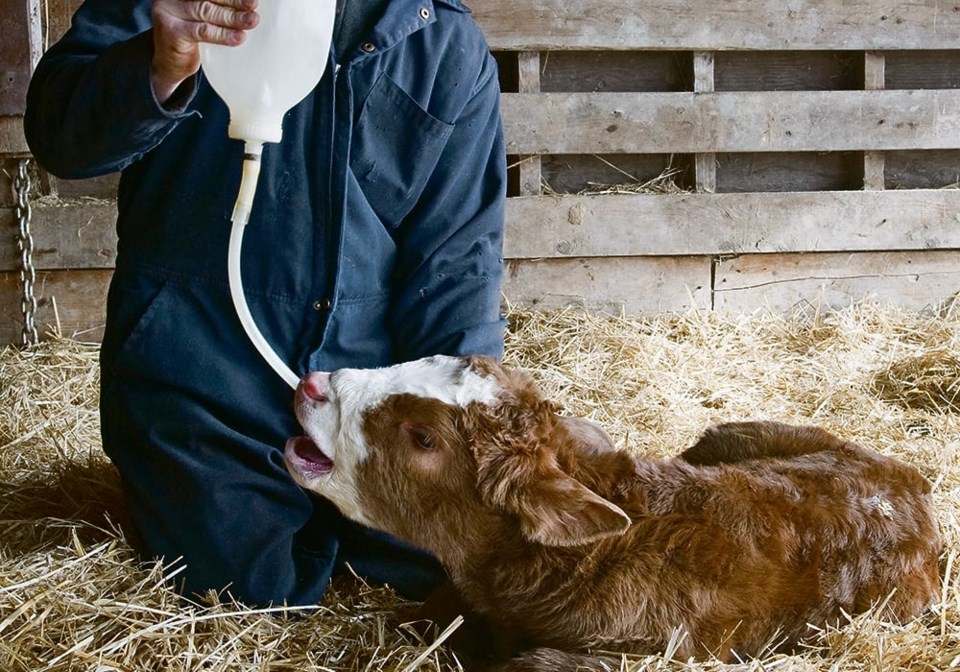REGINA — Get them breathing, get them up and get them fed are Dr. Claire Windeyer’s three tips for cattle producers who have just witnessed a calf being born.
The latter, and the use of colostrum, drew several questions during a recent Beef Cattle Research Council webinar on calf care.
Windeyer said assisted deliveries result in calves with the highest risk of colostrum deficiency, as are calves with weak sucking reflexes, twins, and orphaned or mismothered calves.
But knowing when to intervene, and with what, is important.
“We used to always think that we had 24 hours to get colostrum into calves,” she said during the webinar. “We’ve learned that really the efficiency is the best during that first one to six hours. The antibodies that come in, a lot more of them are going to get absorbed into the gut and then into the bloodstream in that first one to six hours.”
She recommends against using dairy colostrum because its composition is quite different from beef colostrum. The average beef cow in Alberta has about 150 grams of immunoglobulins (IgG) per litre in its colostrum but produces less than a dairy cow.
The average dairy cow has a concentration of about 70 g/L and a higher yield.
“It’s just not the same product. It’s really not what our beef calves are expecting,” Windeyer said.
Dairy colostrum poses a biohazard risk as well, she added.
The dam’s colostrum is the best option if possible, while a dam from the same herd is second best if the producer has frozen colostrum available.
Having a high quality replacement product on hand is important just in case, she said.
Producers usually want to know how much to feed and she said there isn’t much science available for beef cattle.
Research at the University of Calgary veterinary school, where Windeyer teaches, found calves fed 1.4 L with a concentration of 70 g/L nursed from their mothers significantly sooner than others, at 1.7 hours. The other groups got 1L or 2L and nursed at 4.4 hours or 3.6 hours, respectively.
“We kind of call this the Goldilocks effect, that moderation was key there,” she said.
The researchers also looked at IgG absorption and found all the calves received adequate amounts when fed within an hour of birth.
Producers want to know the best way to deliver colostrum. Research looked at bottle feeding, tube feeding and a combination of the two, and again how long it took the calves to nurse from their mothers.
The bottle-fed calves were soonest to nurse, at 2.3 hours, and the combination calves took the longest at 9.2 hours. The tube-fed calves nursed in four hours.
Windeyer said the type of administration didn’t statistically affect absorption, but there were some differences worth mentioning.
Of the combination calves, about half received adequate amounts and half received moderate levels. In the tube-fed group, more than half were adequate but there were also some failures.
“Again, this was not statistically significantly different, but we wonder if maybe there wasn’t something there, that those calves that were tube fed were maybe just not absorbing the colostrum as well.”
However, tube-feeding is better than waiting.
Producers should keep a close eye on calves that are offered bottles but don’t finish them, to make sure they get up and nurse.
There are long-term consequences if calves don’t get enough colostrum in time. Financially there is a cost to purchase the replacement, but there is also the cost of a dead calf, Windeyer said.
There is a higher risk of disease and death, as well as lower gains, up to and past weaning.
Heidi Bennett, cow boss at W.A. Ranches, which is owned by the U of C, said she has found this to be true and said producers should not let colostrum intake fall through the cracks.
If she finds a calf that is obviously a twin or has been mismothered, she jumps in to provide colostrum to help it thrive.
“I believe a calf that gets scours is 30 pounds less in the fall, like they just never really pick up and recover from that,” she said.
Windeyer said producers should monitor by looking at udder fullness and for warm noses and full bellies in the calves.
The webinar also addressed the stages of labour and how to extract calves if assistance is required.
Getting them breathing, if necessary, should not be done by hanging them upside down. Instead, calves should be placed in the recovery position, with their chests up and heads between their front legs. The back feet can be pulled up toward the armpits or ears to stabilize the position.
Tickling the nose with a piece of straw, sticking a finger in the ear, or rubbing the calves with towels also help.
Windeyer said devices such as laryngeal masks and the McCulloch respirator work well if the calves are not breathing.
Calves that had difficult, assisted births have gone through trauma and can benefit from pain medication, she added.
“We found calves that were difficult pulls had significantly higher biomarkers in their blood for muscle damage.”
Recent research found that beef calves given meloxicam are more active in the first 24 hours because they are up and about. Ketoprofen offered similar benefits.
Also, cows given meloxicam spent more time at the feed bunk and were more active. Those given ketoprofen spent less time on their sides and had lower levels of retained placentas.




